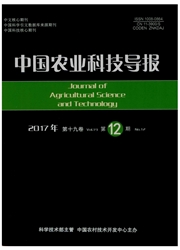

 中文摘要:
中文摘要:
受水资源不足的严重制约,西北绿洲区以间作套种为主体的多熟种植面积被持续压缩,使单位耕地产出率和光能利用率明显下降,间作节水理论和技术研究亟待开展。交替灌溉技术节水和提高水分利用效率的作用已得到大量验证,但该技术应用到间作中能否产生节水、增效作用,缺乏理论依据。2006-2008年,在甘肃河西走廊干旱荒漠绿洲区进行田间试验,探讨了交替灌溉对小麦间作玉米产量、耗水量和水分利用效率的影响。结果表明,与单作相比,交替灌溉小麦间作玉米可显著提高土地利用效率(LER),LER达到1.22~1.52。交替灌溉与传统灌溉间作相比,LER差异不显著;对间作小麦的产量效应不显著,但使间作玉米的产量提高11.4%~36.4%,混合产量平均提高12.9%。与传统灌溉间作相比,交替灌溉间作未显著增加作物的耗水量,与单作小麦、单作玉米的加权平均相比高1.2%-19.4%。交替灌溉小麦间作玉米的WUE较单作小麦高12.0%~71.4%、较单作玉米高10.6%~37.8%、较传统灌溉小麦间作玉米高0.9%~22.5%。在河西绿洲灌区,小麦间作玉米上应用交替灌溉技术具有节水和提高WUE的可行性。
 英文摘要:
英文摘要:
In oasis irrigation region of northwestern China, the decreasing of multiple cropping areas may lead to significant reduction of land and light use efficiencies due to serious water shortage. Therefore, water-saving irrigation is a priority in the research on theory and technology for intercropping system. Alternate irrigation is a technique to save water and enhance water use efficiency (WUE) simultaneously in common cropping systems. However, its effect is not clear on intercropping system. In 2006-2008 cropping years, we carried out a field experiment in oasis region of Hexi Corridor, Gansu province, China under wheat/maize intercropping to disclose the effects of alternate irrigation on crop yields, water consumption, and WUE. The results showed that, compared to sole cropping treatments, there was a significant increase of land equivalent ratio (LER) in the alternately irrigated wheat/maize intercropping treatment with the LER values ranging from 1.22 to 1.52 under different irrigation levels of the intercropping treatments. However, the difference of LERs between conventionally irrigated and alternately irrigated intercropping systems was not significant at the same irrigation quota. Compared to the conventionally irrigated intercropping treatment, there was no significant change of wheat yield in the alternately irrigated intercropping treatment, but significant in- crease by 11.4-36.4% in maize yield. Therefore, the total yield of wheat and maize in the alternately irrigated intercropping treat- ment was increased by 12.9 averagely. The water consumption in the alternately irrigated intercropping treatment had no significant increase compared to that of the conventionally irrigated intercropping treatment, with 1.2-19.4% higher than the weighted average of monoculture of both crops. The WUE of alternatiely irrigated intercropping treatment was 0.9-22.5% higher than that of the conventionally irrigated intercropping treatment, and 12.0-71.4% and 10.6-37.8% higher than that of wheat and maize monocu
 同期刊论文项目
同期刊论文项目
 同项目期刊论文
同项目期刊论文
 Root distribution and yield responses of wheat/maize intercropping to alternate irrigation in the ar
Root distribution and yield responses of wheat/maize intercropping to alternate irrigation in the ar 期刊信息
期刊信息
